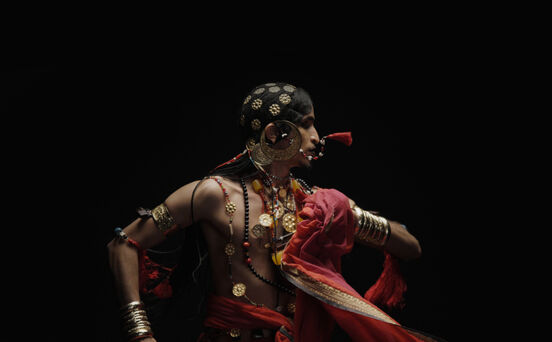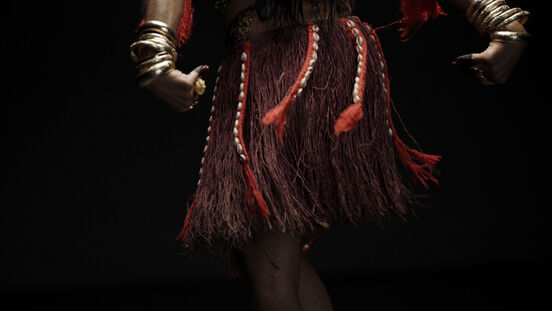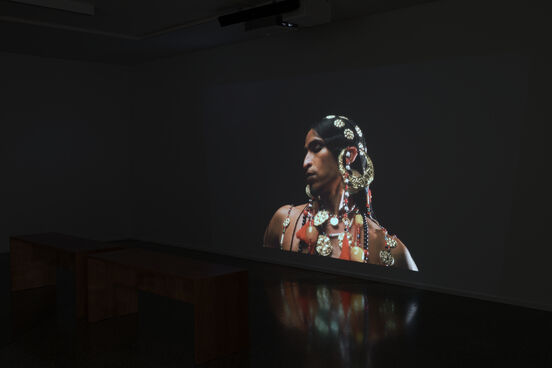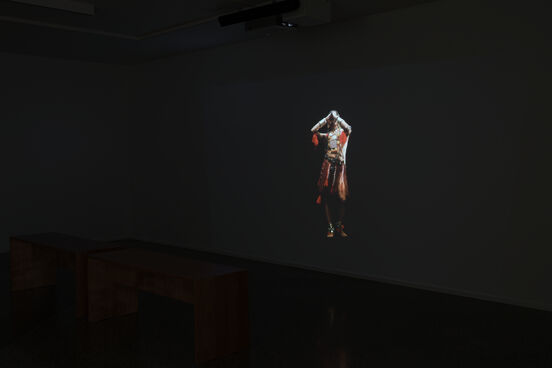-
Author
Ahmed Umar -
Date
16 Apr 2025
Essay
Talitin – تالِتِن
A story of melting in the Bridal Dance
The drums are teleporting all of us into a realm of ecstasy and much love. Her eyes are locked towards the sky, gracefully, as if she were whispering secrets to the divine. My mother, “melting” like a goose smoothly swimming in the water, in our traditional dance. Sways left and right with her shoulders while her hips move up and down. This was one of my fondest memories of my mother and of the dance at all.
My name is Ahmed, proudly titled “mother’s boy” and “Talitin.” I grew up in Mecca, Saudi Arabia, in a Sudanese family that loved life, music, traditions, and Allah. I am the youngest of my five siblings, and the most... “special.” Uniquely among my siblings, I received and conveyed life lessons differently. I was laconic with words but loud with my body: drawing, dancing, and throwing tantrums.
I balance-walked life through numerous contrasts. Art, no art. Music, no music. Dance, no dance. Wahhabism, Sufism. Devotion to religion, Atheism. Residing in a male body in a patriarchal society, non-binarism.
The story I am inviting you into begins with a disinvitation. Precisely, from the time I was escorted out of the fantasy world the females of my family, and beyond, have passionately created. The world of the Bridal Dance and the Girls Music genre and my cousin’s wedding.
As Sudanese people, and despite the excruciating colonial history, bloodbaths, and wars, we are avid joyseekers, dare I generalize! We commune everywhere and at every opportunity. For instance, our weddings are traditionally seven days of celebration, rituals, and lots, lots of dance. The bride rounds off the whole festival with a dance she entertains herself, her husband-to-be, and all the attendees with. The Bridal Dance, a gem of culture passed from woman to woman through hundreds of years, maybe even thousands. It is one of the few traditions that resisted Arab and English colonization and the multiple waves of the so-called Islamization of Sudanese society. It remained authentic, yet open and inclusive to new trends in dance and music.
As the final ritual that marks the transition from girlhood to womanhood, the bride dances showing off her beauty, agility, wealth, and fitness to carry the next generation. She would be dressed in a skirt-like garment made with fine leather fringes, The Rahat, her upper body covered only with golden coins and beads as breasts were not as sexualized in most Sudanese tribes before. Golden bracelets, armlets, anklets, and leather amulets. The bride’s entrance to the dance floor is a grand event, the moment everyone is waiting for. She arrives led by her groom on her left side, completely covered with Firkat AlGarmasis, a colorful silky fabric that every bride gets in her dowry. Then reveals herself, aweing whoever attends the ceremony. She then starts to dance to a set of songs curated specifically for her by her dance teacher/singer called in Arabic, Allama. The Allama’s role is to choose songs and moves that enhance the beauty of the bride, sing for her, and present her in the best possible way. The dance is sensual, sexual, and embodies plenty of pride and power.
Some decades ago, the bridal dance was an open event that everyone attended. Men, women, children, and all in between. But after four and a half decades of dictatorships that used women’s bodies to battle for morality and virtue, the dance was forced to the underground, dresses also included to cover the bride’s bodies. In the nineties of the past millennia, the whole ceremony became, tragically, women-exclusive, if it is ever held.
I was captivated by the dance since my early childhood. Its intricate movements, the vibrant music, the atmosphere of pure joy – it was mesmerizing. I would often find myself imitating my mother when she danced it. Much to the amusement and sometimes disapproval of my family, especially my father who discouraged my boundary-less attitude. He believed, strengthened by the common culture and religion, that parallelism is the way to exist. Men should be men, and women should be women. Two paths that never cross each other.
As I grew older, the expectations of the patriarchal society I lived in became more pronounced. The world I had been so freely part of as a child was suddenly off-limits. My presence, and dance, once tolerated as a child, was now deemed inappropriate. I was disinvited, escorted out of the fantasy world that had nurtured my love for movement. This disinvitation was not just from the bridal dance of my cousin, but from a part of my identity. It was a harsh reminder of the rigid gender norms that dictated what was acceptable for me as a male in our society. Yet, this disinvitation also marked the beginning of my journey to challenge these norms. To navigate the delicate balance between tradition and self-expression, between societal expectations and personal authenticity. I began this challenge with sneaking from the balcony and seeing my cousin’s bridal dance, after getting kicked out.
I wanted to dance, to say what my words could never express. I dreamed of being a dancer in Mecca, in a society that viewed music as the devil’s tool to corrupt us humans. Music was forbidden because it has the power to change us, make us move. And the older and more profiled I got, the higher the bar to dancing became. No Allama was ready to pass a male body our ancestor’s legacy. I kept looking and asking around for a few years. Until I found Asia Madani, a professional Allama based in Cairo, Egypt. Once in a written chat, I threw at her a joke that I totally meant: “I know you sing and teach brides to dance, how crazy is it if I ask you to teach me the bridal dance?”
She responded, “Definitely not so crazy. I can teach you.”
I said, in a voice note: “Listen, if you are serious, I will book a ticket to Cairo right now.”
“Yes, yes, I am more than willing to be your Allama.”
And soon enough, I was in the middle of the charming chaos of Cairo’s streets, in a café, planning with Asia and my creative and soul sister, Alsarah, who’s a Sudanese artist and dance performer herself, planning my bridal dance and picking songs and movements that can flaunt my beauty. I was, and still to this day, ecstatic.
We picked twenty-five songs that represent multiple stages of love and courtship between the wedded couple, and different dances from various parts of Sudan. Brides usually learn their dance in three months, but because I was blocked from seeing the dance from a young age, I immersed myself in perfecting the dance for a whole of three years. My intention is to present the dance with the respect it deserves, harmonious, serious, daring and radiating much love. Not just as a traditionally female dance presented by a male body. It is worth noting that there is no proper documentation existing online for the bridal dance. Just a few short, leaked videos that cost the brides much of their reputation, in addition to infringing their privacy. The brides powerfully danced for two to three hours, with different costume changes and breaks. But I danced for 26 minutes.
In the process of claiming back the dance as a communal activity done with pride, I re-entered the happy world I once was part of before reaching ten years of age. I also re-owned the slur used to degrade me from as long back as I can remember, to this day; “Talitin – تالِتِن†” Which literally translates to: the third of two girls. It is culturally used in Sudan against a boy who enjoys the company and activities of women. Like me. Talitin is the title of my bridal dance performance at The 60th Biennale d’Arte di Venezia.
Guided by Alsarah, I shared my bridal dance performance two times at the Sala D’armi in the Arsenale during the pre-opening days of the Biennale. I must admit when Adreano Pedrosa, the curator of the Biennale, asked specifically for the dance I was overjoyed by having my dream about showing at the Biennale coming true, yet overwhelmed with a sense of responsibility for the presentation of such precious heritage.
I did all I could to preserve the spirit of dancing from the time of my grandmother. I collected the costume elements for more than six years, from several places around the world. The antique market in Omdurman, Sudan, New York, Oslo and some parts I could not find in the markets I got them crafted in Cairo, Egypt. My references were the stories my grandfather eagerly told about my grandmother’s dance. How enchanted by her beauty he was, how this memory lived in him for over sixty years and recounting it to us with such fascination. He even imitated some of her movements. Embarrassed, with a love that I have not seen in a human before, and while smiling garndma said: “your grandpa is too old he lost his mind.”
I was also inspired by the Jadla, the bridal dance costume, grandma made for my aunts. Vibrant and colorfully beaded set with a braided wig, multiple jewelry to adorn the whole body, almost, mixed plenty of golden coins.
The last time I saw this Jadla was when I was a small child. It stuck in my memory for a bout three decades until I returned to my grandmother’s village after 10 years looking for it. Sadly, it was nowhere to be found. Even my aunts barely remembered its existence!
I made my Jadla by myself. A statement that is not precise since my grandmother’s spirit was present in step of putting the costume together.
Here I am in Venice, a link between a long line of my grandmother, mother and generations of Sudanese women and the world. I could not be more nervous. My heart was beating unrhythmically, my digestive system did not accept any food, my limbs were going cold. Despite my deep love for dancing, I am not used to performing in front of people.
Completely covered with my Firkat AlGarmasis , Alsarah holds my hand and walks me to the middle of the Berish - handwoven palm leaf mats- while singing a traditional bridal-entry song. Then she leaves me at the center of the Berish, where it also is the center of all eyes. The music of Asia Madani starts. I recall I moved my right foot first, then smoothly my shoulder swings, and then my hips sway, up and down. My eyes are locked up, as if I am looking to the skies. I am re-living my mother’s dance. Whispering to what felt like a divine ancestors: I hope I am “melting” like a goose smoothly swimming in the water.
That's how we describe a good dancer in Sudan.


(above) photographs by Jakob H Svensen

(above) Ahmed Umar, Talitin, تالِتِن The Third, 2023–2024, photographs by Sam Hartnett
